Physical Address
304 North Cardinal St.
Dorchester Center, MA 02124
Physical Address
304 North Cardinal St.
Dorchester Center, MA 02124
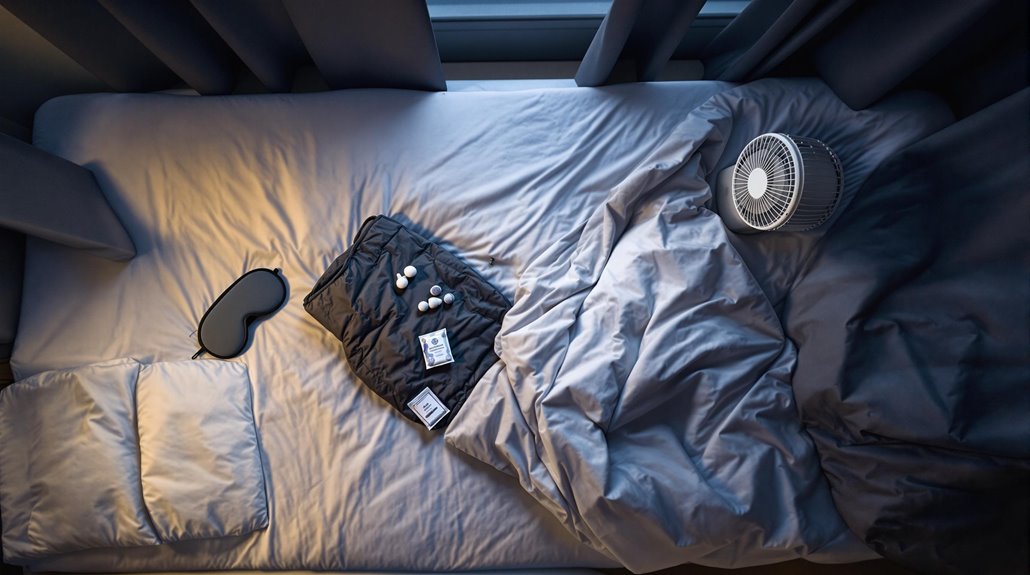
Choose a bottom bunk in a corner spot away from high-traffic areas, and bring essential sleep gear like noise-canceling earplugs and a contoured eye mask. Create your sleep sanctuary with breathable sheets and a personal fan, while using under-bed storage to stay organized. Establish a pre-sleep routine, avoiding caffeine and screens before bed. Secure your belongings in lockers, and use white noise apps to mask disturbances. These fundamental strategies set the foundation for exploring more advanced hostel sleep tactics.
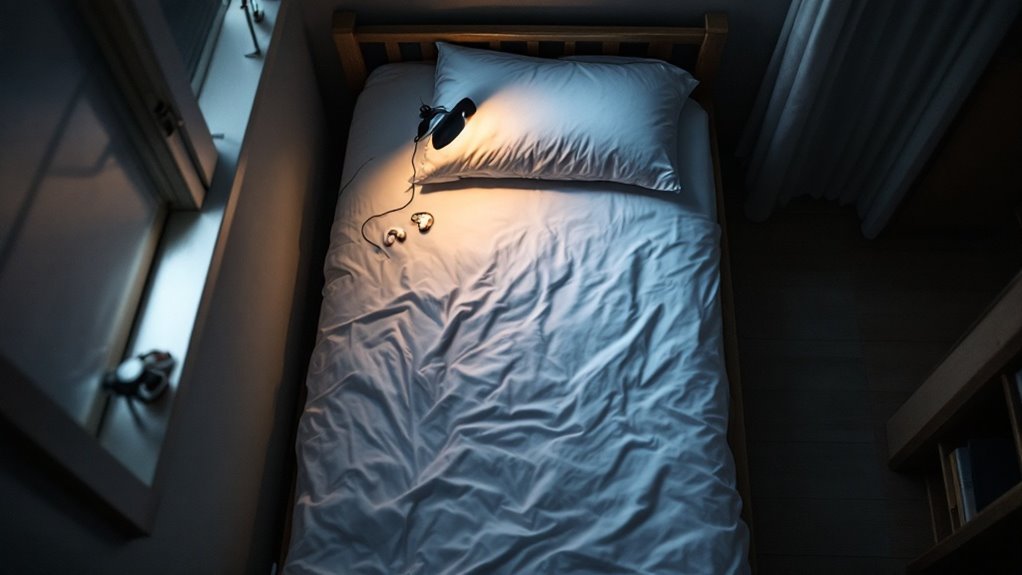
While getting a good night's sleep in a hostel can feel like a game of chance, choosing the right bed position can considerably improve your odds of peaceful rest.
If you're sensitive to temperature, opt for a bottom bunk since heat rises to the top beds. Bottom bunks also minimize disturbances from other travelers using ladders or making late-night bathroom trips.
Consider selecting beds away from common areas or bathrooms to reduce noise exposure throughout your stay.
However, if you're bothered by overhead lighting or hallway activity, you might prefer a top bunk for added privacy.
Regardless of your choice, avoid beds next to high-traffic areas or ladders where fellow travelers frequently pass by.
You'll create fewer disturbances for others in a bottom bunk, as your movements won't shake the bed frame like they'd in a top position.
Packing the right sleep gear makes the difference between tossing all night and getting solid rest in a hostel dorm. When it comes to essential items, noise-canceling ear protection should top your list.
Look for high-decibel reduction models offering at least 27 dB SNR to effectively block out snoring and street noise. If you're a side sleeper, opt for silicone options like Loop Dream, while foam varieties expand to create a secure seal for any sleeping position.
Quality earplugs with 27+ dB reduction are essential for hostels. Choose silicone for side sleeping or foam for universal fit.
Don't forget a quality light-blocking eye mask with a contoured design to prevent pressure on your eyelids during REM sleep. Choose one with adjustable straps that won't slip off during the night. A microfiber travel sheet can also help you feel clean and comfortable while protecting you from questionable bedding.
For maximum noise reduction, you can layer noise-canceling headphones over your earplugs, creating an effective sound barrier against even the loudest dorm mates.
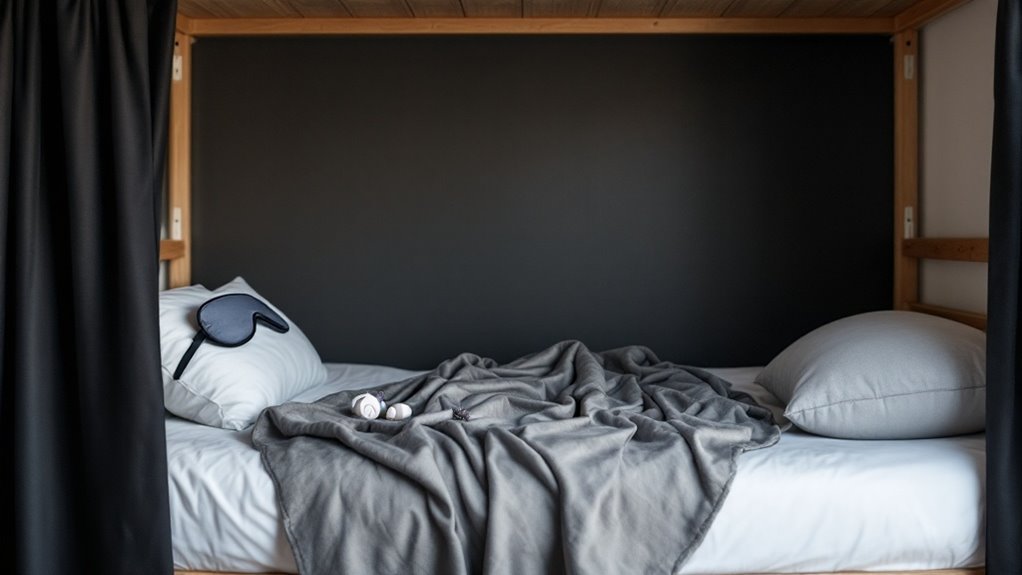
Creating a cozy sleep sanctuary in a bustling hostel dorm requires attention to multiple sensory elements. You'll want to control light exposure by using a contoured sleep mask and securing curtains with clips, while positioning your bed away from high-traffic areas. Maintaining a consistent sleep temperature range around 65°F helps regulate your body's natural rhythms.
For temperature comfort, layer breathable sheets and keep a USB fan handy for personal climate control.
Remember to organize your belongings efficiently, using under-bed storage and bedside organizers to maximize space while keeping essentials within reach.
These small adjustments can transform even the busiest dorm into your personal haven.
Managing noise effectively in a hostel environment can make the difference between a restless night and quality sleep. For immediate relief, invest in quality foam or silicone earplugs, which can reduce noise by up to 33 decibels – enough to block out typical hostel disturbances like snoring and conversations.
You'll also want to download a white noise app on your phone, as these can mask irregular sounds like door slams and footsteps. Adding a rolled towel under the door can significantly reduce noise from hallway traffic.
If you're staying longer, consider strategic furniture placement to create a quieter space. Position your bed against a wall rather than near the door, and if possible, choose a bottom bunk to reduce exposure to movement noise.
During extended stays, you can even negotiate quiet hours with your roommates, which has been shown to reduce nighttime disturbances by 65%.
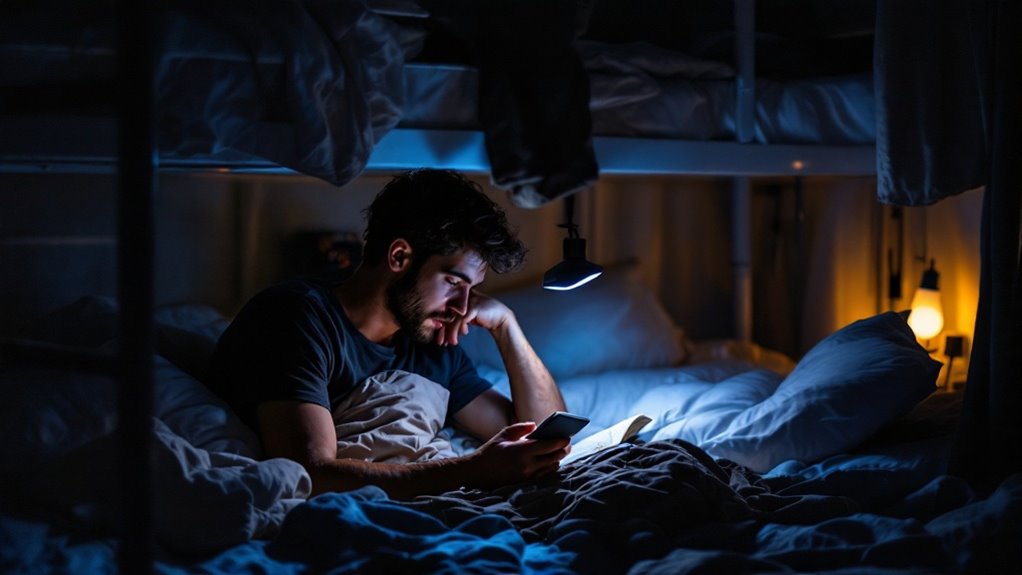
While light management might seem trivial compared to noise control, it's actually one of the most essential factors for quality sleep in shared hostel spaces.
You'll discover that smart lighting strategies can dramatically improve your sleep quality, especially when dealing with different schedules in a dorm setting.
Remember to use your smartphone's flashlight or low-intensity red lights when moving around after quiet hours, rather than flipping on overhead lights.
Many hostels now provide individual lighting controls at each bed to comply with modern building standards, making it easier to manage your personal lighting needs without disturbing roommates.
Even in the most chaotic hostel environments, establishing a consistent sleep schedule stands as your strongest defense against travel fatigue and jet lag.
You'll want to aim for at least seven hours of sleep each night, keeping your wake and bedtime consistent even on weekends. Start winding down 30-60 minutes before bed with calming activities like reading or journaling, and avoid screens that emit sleep-disrupting blue light. A soothing cup of chamomile tea can help you unwind naturally before bedtime.
If you're traveling across time zones, gradually adjust your schedule a few days before departure, especially for eastward journeys.
Once at your destination, seek morning sunlight to reset your biological clock, and don't schedule important activities on your first day.
Consider using a silent, vibrating alarm under your pillow to avoid disturbing dormmates while maintaining your chosen schedule.
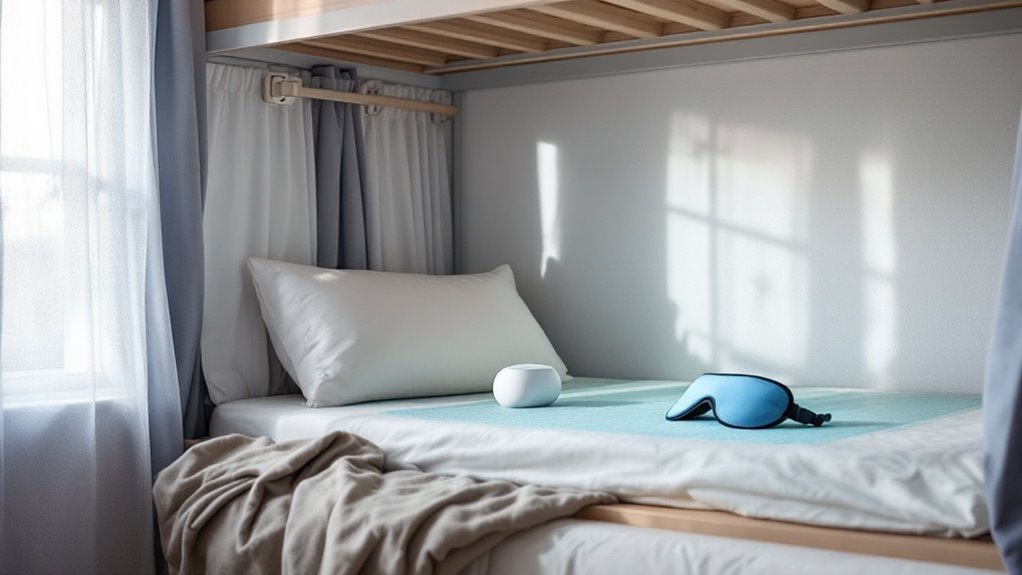
The right temperature and comfort setup can make or break your hostel sleep experience, building upon the benefits of a well-planned schedule.
You'll want to aim for a room temperature between 65-70°F (18-21°C), which research shows improves sleep quality for most travelers. Sixty-nine percent of travelers report more restful sleep in cooler environments. When possible, use programmable thermostats or speak with staff about adjusting overheated rooms instead of opening windows, which can waste energy and create uncomfortable drafts.
Since your body needs time to wind down before sleep, establishing a consistent pre-sleep routine in hostels can dramatically improve your rest quality.
Start by disconnecting from your devices 1-2 hours before bed, as blue light exposure can disrupt your natural sleep cycle. Instead, engage in calming activities like reading, journaling, or practicing mindfulness meditation.
To prepare your body for rest, avoid caffeine and heavy meals in the evening, opting for light snacks if you're hungry. Maintaining a room temperature between 60-67 degrees Fahrenheit will help optimize your sleep environment.
You'll also want to reduce fluid intake 1-2 hours before bed to minimize nighttime bathroom trips.
Consider using aromatherapy, such as lavender oil, and practice deep breathing exercises or progressive muscle relaxation while lying down.
Writing down tomorrow's plans earlier in the evening can help clear your mind of pre-sleep anxiety.
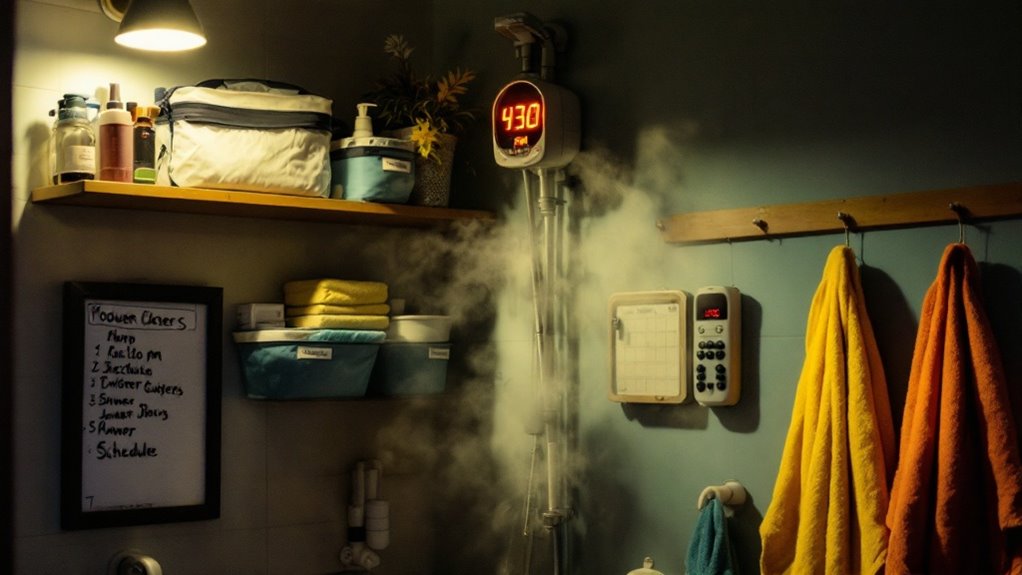
Managing shared bathrooms effectively can make or break your hostel experience, as these communal spaces often become central hubs during peak hours. To maintain hygiene and comfort, you'll need to develop smart strategies for timing your bathroom visits and carrying your essentials.
Smart bathroom management is crucial for hostel stays – timing and organization can transform your shared facility experience from chaotic to comfortable.
Consider showering during off-peak afternoon hours, and always wear flip-flops to protect your feet from bathroom floors. Some facilities may require you to obtain a special bathroom key for access and security.
Remember to clean up after yourself and keep your bathroom visits brief, typically 5-10 minutes, to be considerate of others waiting.
Living with disruptive roommates in hostels can test even the most patient travelers, but you'll discover that proper preparation and communication make all the difference.
Start by initiating open conversations about sleep preferences and quiet hours during your first interactions, using "I" statements to maintain a positive rapport.
When noise becomes an issue, layer your defenses with high-quality earplugs and noise-canceling headphones, while using white noise apps or small fans to mask irregular disturbances. Creating a relaxing environment can help ensure you get restful sleep patterns.
Choose your bed strategically by selecting bottom bunks near walls and away from high-traffic areas.
If problems persist, don't hesitate to document recurring issues and report them to hostel staff with specific examples.
For chronic disruptions, request a transfer to designated quiet floors or consider alternative accommodations.
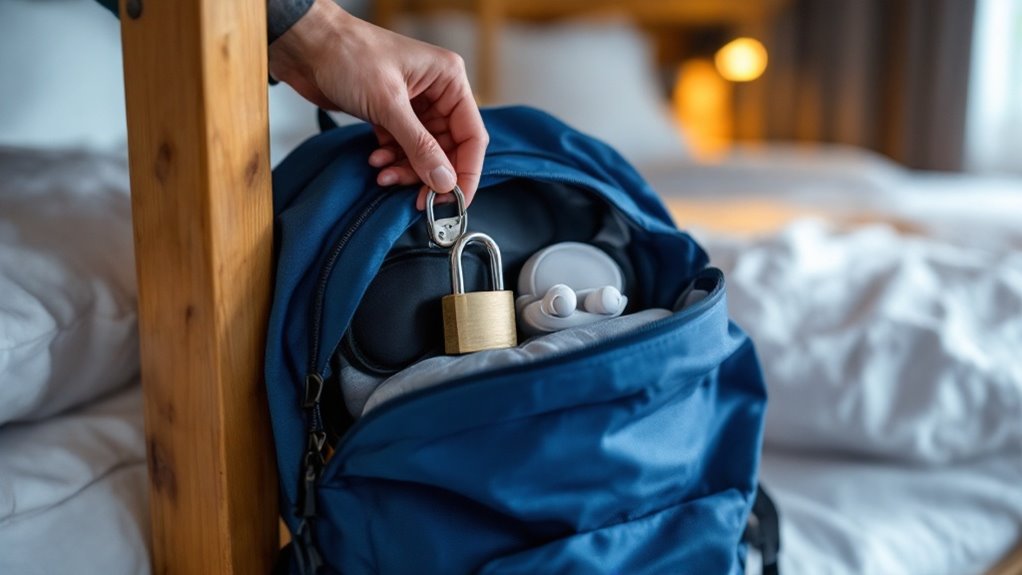
A restful night's sleep often hinges on knowing your belongings are secure, which brings us to another key aspect of hostel life.
You'll want to maximize the use of lockers, storing all valuables like passports, cash, and electronics inside them before bedtime. For items that won't fit in lockers, consider using a cable lock to secure your backpack to the bed frame, positioning it discreetly under your bed or in a corner. Consider using key padlocks rather than combination locks for better security.
These security measures will help you relax and drift off to sleep without worrying about your belongings.
Strategic room arrangement can make or break your hostel sleeping experience, and choosing the right bed location serves as your foundation for quality rest. If you're seeking minimal disruption, opt for a bottom bunk in a corner spot, where you'll benefit from reduced foot traffic and better temperature control.
You'll also want to position your bed perpendicular to windows to avoid early morning sunlight.
Consider selecting a bed in smaller dorm rooms with four to six beds rather than larger ones, as they typically offer a quieter environment.
When arranging your space, use over-bed shelves and under-bed storage to keep essentials within reach while maintaining organization. Installing vertical wall shelves can provide additional storage while keeping floor space clear for better movement.
Don't forget to set up a designated charging station nearby, and use clip-on reading lights to avoid disturbing others during nighttime activities.
Getting a good night's sleep in a hostel dorm is like mastering a strategic game – with the right preparation and mindset, you'll win every time. By implementing these practical tips for bed selection, essential gear, and smart room management, you're setting yourself up for restful nights during your travels. Remember, quality sleep isn't just about comfort; it's the foundation of an enjoyable backpacking experience that'll keep you energized for new adventures.